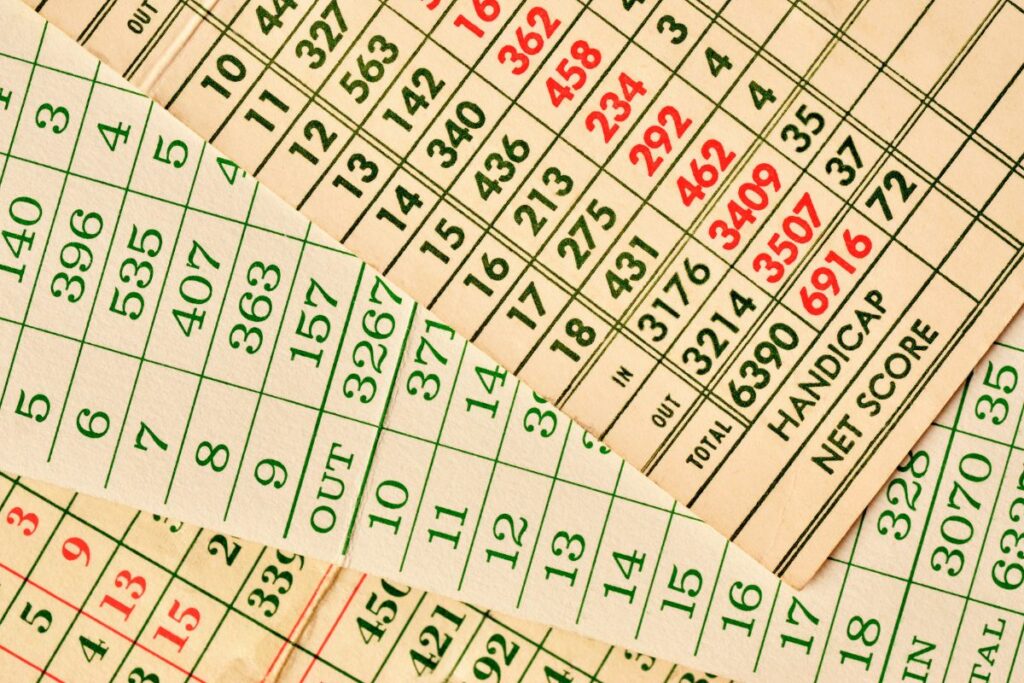We occasionally recommend products we love and might be paid a share of the sale.
One common golf term you may have heard from golfers or golf commentator is GIR. But what does GIR mean in golf?
GIR, or “greens in regulation,” refers to the standard number of shots it stakes a golfer to get to green on each hole. The exact number depends on the par for the hole. If you get the ball on the green within the designated number of shots, you will have hit the green in regulate and earned the GIR.
This article explains everything you need to know about GIR. We’ll cover what it is, what it stands for, and some examples of GIR. There are also frequently asked questions people have about GIR and the answers to those questions.

What Does GIR Mean in Golf?
GIR means green in regulation. To qualify as a GIR, the player’s ball must be on the green in a certain number of strokes for each hole. The GIR for any particular hole depends on the par for that hole.
Here is the GIR for each hole depending on par:
- Par 3: GIR is one shot
- Par 4: GIR is two shots
- Par 5: GIR is three shots
Remembering the GIR for each hole is easy. The GIR is always par minus two strokes. In general, if you want to make a par, you should get the ball on the green in regulation and make the ball in the hole with two putts to complete your par for the hole. Working backwards you can see that means one, two, or three shots to get on in regulation depending on the par for the hole.
GIR can describe hitting a single green in regulation, but it can also be used as a statical average calculated over a single round, a whole tournament, the entire season, or even a players entire career.
The better a player’s GIR, the better their score is likely to be for the round of golf. GIR is a good metric to describe how accurately the player hit their approach shots. The more accurate the approach shots, the more likely the player is to make pars and birdies.
However, remember that the phrase is “in regulation,” which only means that the GIR is the most common and standard way to get par. Players can still score well with a poor GIR percentage if they get the ball up and down consistently.
If you struggle with your long shots, you might have a low GIR. That does not mean you will have a bad round of golf so long as you have a very good short game.
On the other hand, you might have a very good GIR if your accuracy is great. But you could still have a bad round if you putt the ball poorly.

GIR Examples
In golf, there are three different holes you could come across when it comes to par, and all three have a different standard for GIR.
Let’s look at some examples for GIR.
Par 3 GIR
First, for a Par 3, you know you need to get your ball on the green on your first shot to get the GIR. It’s also a requirement is you’re playing the nearie golf game.
But what if you miss the green on your first shot, chip onto the green, then putt it in for par? No, you still do not get the GIR since you missed the green. What matters for GIR is how many shots you take to get on the green.
Even if you miss the green on your first shot, then chip it in for a birdie, you still did not hit the GIR.
If you miss the green on your first shot, the green in regulation is lost for a par 3. However, if you get a hole-in-one, the GIR does count.
Par 4 GIR
The same par minus two equation is used for par 4 holes. If your ball is not on the green within the first two shots on a par 4, you will not get credit for the GIR.
The most common way to earn a green in regulation on a par 4 is hitting the green with the second shot. This is usually easiest when you’re playing from the fairway, but you can still get the GIR from the rough or fairway bunker.
If you somehow manage to hit the green with your first shot, you will get the GIR as long as you don’t putt the ball off the green on your second shot.
Par 5 GIR
For a par 5, you can get the GIR if you hit the green in the first three shots on the hole. But if it takes you four or more shots to get the ball on the green, there is no GIR.
Most people will hit the green on their third shot, but sometimes players can hit the green in two shots. Longer players will frequently be able to reach the green on par 5 holes in only two shots.
Just be careful, if you manage to get on the green in two shots, but somehow putt the ball off the green with your third shot, the GIR may not qualify.

Frequently Asked Questions About GIR
What Does GIR Stand For in Golf?
GIR in golf stands for green in regulation.
How is golf GIR calculated?
To calculate the GIR on a specific hole, you just need to take the par number for the hole and subtract two. For example, GIR on a par 3 is one shot, so you have one shot at getting the ball on the green.
Then, if you want to calculate your GIR percentage for the whole round, you will take the number of GIRs you hit and divide it by the number of holes you played.
For example, if you hit 14 GIR in 18 holes, your GIR would be 14/18 or 77%.
Is GIR Important?
GIR is a common stat for professional and serious golfers to track. It is an easy statistic to use to measure a player’s approach accuracy. In general, the higher the GIR, the better a player is.
But, if you have a good short game, you can still play well with a low GIR. So, it is not the only stat to use, and it is not always an accurate measure of how good a player is.
What is FIR?
Another golf term similar to GIR is FIR. FIR means fairway in regulation. You need to hit the fairway on your first shot off the tee to earn the FIR.
The FIR only applies on holes with par 4 or 5. For a par 3, there is no FIR because there is no fairway to hit. Instead you will be trying to get the GIR with your first shot.
Final Thoughts
GIR, or green in regulation, measures how accurately you are hitting the green in the standard number of strokes in golf. The GIR is either one, two, or three for a hole depending on the par for that hole. You can calculate your GIR percentage for a round by taking the number of GIRs you hit and dividing it by the number of holes you played.
Looking for more information on common golf abbreviation? See our recent article on what WD means in golf, and another post that explains what MC means in golf. And you’ll definitely want to see our resource covering the funniest golf terms!
- Funny Golf Terms - February 21, 2023
- How To Play Vegas Golf Game - February 16, 2023
- How To Play Wolf Golf Game - February 16, 2023








